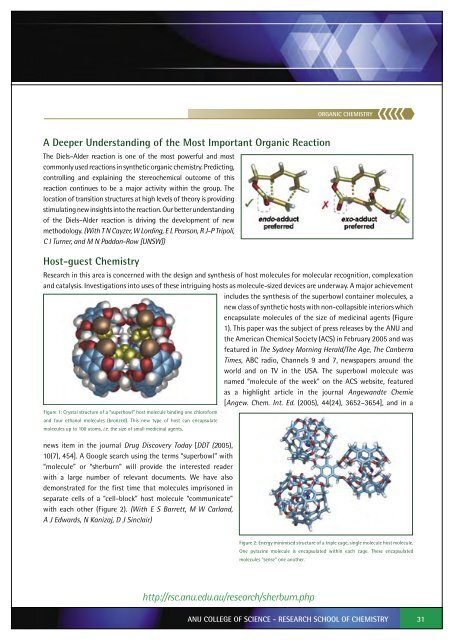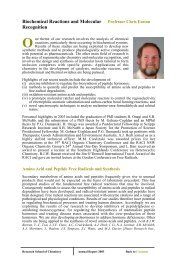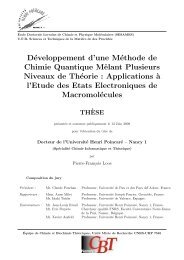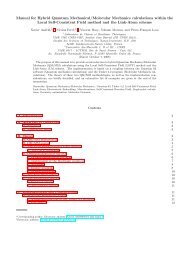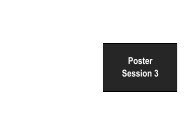View 2005 Report - RSC - Australian National University
View 2005 Report - RSC - Australian National University
View 2005 Report - RSC - Australian National University
Create successful ePaper yourself
Turn your PDF publications into a flip-book with our unique Google optimized e-Paper software.
ORGANIC CHEMISTRY<br />
A Deeper Understanding of the Most Important Organic Reaction<br />
The Diels–Alder reaction is one of the most powerful and most<br />
commonly used reactions in synthetic organic chemistry. Predicting,<br />
controlling and explaining the stereochemical outcome of this<br />
reaction continues to be a major activity within the group. The<br />
location of transition structures at high levels of theory is providing<br />
stimulating new insights into the reaction. Our better understanding<br />
of the Diels–Alder reaction is driving the development of new<br />
methodology. (With T N Cayzer, W Lording, E L Pearson, R J-P Tripoli,<br />
C I Turner, and M N Paddon-Row [UNSW])<br />
Host-guest Chemistry<br />
Research in this area is concerned with the design and synthesis of host molecules for molecular recognition, complexation<br />
and catalysis. Investigations into uses of these intriguing hosts as molecule-sized devices are underway. A major achievement<br />
includes the synthesis of the superbowl container molecules, a<br />
new class of synthetic hosts with non-collapsible interiors which<br />
encapsulate molecules of the size of medicinal agents (Figure<br />
1). This paper was the subject of press releases by the ANU and<br />
the American Chemical Society (ACS) in February <strong>2005</strong> and was<br />
featured in The Sydney Morning Herald/The Age, The Canberra<br />
Times, ABC radio, Channels 9 and 7, newspapers around the<br />
world and on TV in the USA. The superbowl molecule was<br />
named “molecule of the week” on the ACS website, featured<br />
as a highlight article in the journal Angewandte Chemie<br />
[Angew. Chem. Int. Ed. (<strong>2005</strong>), 44(24), 3652–3654], and in a<br />
Figure 1: Crystal structure of a “superbowl” host molecule binding one chloroform<br />
and four ethanol molecules (bronzed). This new type of host can encapsulate<br />
molecules up to 100 atoms, i.e. the size of small medicinal agents.<br />
news item in the journal Drug Discovery Today [DDT (<strong>2005</strong>),<br />
10(7), 454]. A Google search using the terms “superbowl” with<br />
“molecule” or “sherburn” will provide the interested reader<br />
with a large number of relevant documents. We have also<br />
demonstrated for the first time that molecules imprisoned in<br />
separate cells of a “cell-block” host molecule “communicate”<br />
with each other (Figure 2). (With E S Barrett, M W Carland,<br />
A J Edwards, N Kanizaj, D J Sinclair)<br />
Figure 2: Energy minimised structure of a triple cage, single molecule host molecule.<br />
One pyrazine molecule is encapsulated within each cage. These encapsulated<br />
molecules “sense” one another.<br />
http://rsc.anu.edu.au/research/sherburn.php<br />
ANU COLLEGE OF SCIENCE - RESEARCH SCHOOL OF CHEMISTRY<br />
31


